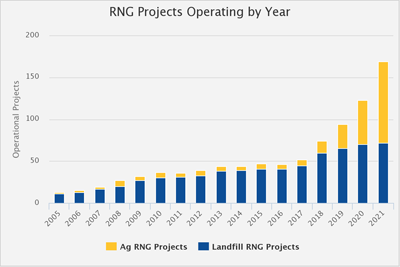Table of Contents
Renewable Natural Gas (RNG) is a growing trend in the energy sector, offering an alternative to traditional natural gas that is cleaner and more environmentally friendly. In this article, we will provide an overview of RNG, including its composition, benefits, and production methods. We will also explore the differences between traditional natural gas and RNG, the current state in the energy market, the RNG Coalition, and the future outlook for RNG. By the end of this article, you will have a comprehensive understanding of Renewable Natural Gas and its role in the clean energy sector.
Introduction to Renewable Natural Gas (RNG)

What is Renewable Natural Gas (RNG)?
Renewable Natural Gas (RNG) is a type of natural gas that is derived from organic waste and is a low-carbon alternative to traditional natural gas. This waste can include livestock manure, food waste, sewage, and even landfills, as opposed to being obtained from non-renewable fossil fuels. The process of creating RNG captures and refines the methane produced by this waste and is then purified and transformed into a gas similar to traditional natural gas called biomethane. RNG is considered a more sustainable and eco-friendly source of energy because it is generated from renewable resources. As a result, it has a smaller carbon footprint compared to traditional natural gas.
How RNG is Used
Renewable natural gas (RNG) can be used for a variety of applications, including:
• Heating: RNG can be used to heat homes and commercial buildings, as well as to produce hot water.
• Power Generation: RNG can be burned to produce electricity, making it a clean and renewable source of energy.
• Transportation: RNG can be used as a fuel for vehicles, such as trucks, buses, and heavy-duty equipment, helping to reduce greenhouse gas emissions.
• Industrial Processes: RNG can be used as a fuel or raw material in industrial processes, such as the production of chemicals and fertilizers.
• Agriculture: RNG can be used to fuel equipment and vehicles on farms, as well as to provide energy for livestock operations.
Biomethane and its Role in Renewable Natural Gas
Definition of Biomethane
Biomethane is a type of renewable gas that is produced from organic waste materials. It is produced through a process called anaerobic digestion, where microorganisms break down the organic matter in the absence of oxygen. The result of this process is a mixture of biogas and biomethane, which can be used as a clean energy source.
Importance of Biomethane in RNG Production
Biomethane plays an important role in the production of Renewable Natural Gas (RNG). It is one of the main sources of renewable gas that is used in RNG production processes. The biomethane produced from the anaerobic digestion of organic waste is purified and upgraded to pipeline quality, making it suitable for use as a fuel source. This purified biomethane is then blended with traditional natural gas to create RNG, which is considered a cleaner form of energy compared to traditional natural gas. In this way, biomethane is an essential component of RNG production and is helping to drive the growth of the renewable gas industry.
Comparison with Traditional Natural Gas
Natural gas and renewable natural gas (RNG) are both forms of gas that can be used for heating, electricity generation, and transportation fuel. While RNG has a similar chemical composition to traditional natural gas, there are important differences between the two.
Origin
Natural gas is a fossil fuel, formed from the remains of ancient plants and animals that have been buried and subjected to high pressure and heat over millions of years. RNG, on the other hand, is produced from organic matter, such as food waste, agricultural waste, and sewage, through a process called anaerobic digestion.
Renewability
Natural gas is a finite resource that will eventually run out,
 while RNG is considered a renewable energy source because the organic matter that produces
it is constantly replenished through natural processes.
while RNG is considered a renewable energy source because the organic matter that produces
it is constantly replenished through natural processes.
Methane Emissions
One of the main concerns about natural gas production, transportation, and use is the methane emissions they produce. When burned, natural gas releases carbon dioxide (CO2) and other greenhouse gases. However, oil, gas, and coal account for only 37 percent of U.S. methane emissions, compared to 53 percent from organics and agriculture where RNG is captured.
RNG is considered carbon-neutral because once captured and processed, the emissions produced during combustion are offset by the carbon dioxide that was removed during the production of the gas making it a cleaner energy source.
Extracting Traditional Natural Gas and capturing RNG
Traditional natural gas is extracted from underground reservoirs through a process known as drilling. The drilling process involves drilling a well into the ground to reach the natural gas deposit. Once the well is in place, the natural gas is pumped to the surface and transported to processing facilities where impurities are removed. From there, it is transported to storage facilities or directly to distribution centers where it is distributed for use as fuel for heating, cooking, electricity generation, and transportation.
There are two main types of natural gas production: conventional and unconventional. Conventional natural gas production involves the extraction of natural gas from underground reservoirs that are relatively close to the surface. Unconventional natural gas production involves the extraction of natural gas from tight formations such as shale rock using techniques such as hydraulic fracturing, or "fracking."
The process of capturing methane begins by identifying sources of methane emissions and developing a plan to collect it. For example, at a landfill, a series of wells are drilled into the waste mass to extract the gas. At a livestock operation, a cover is placed over the manure storage lagoon to capture the gas emissions. Once the gas is captured, it is then purified to remove impurities such as moisture, siloxanes, and hydrogen sulfide.
Overview of RNG Production Processes
The production of RNG involves several steps, including the collection of organic waste materials, the anaerobic digestion process, purification of the biomethane, and its transformation into RNG. As mentioned before, the waste materials used in the production of RNG can come from a variety of sources, including landfills, wastewater treatment plants, and dairy farms. The anaerobic digestion process is performed in special tanks called digesters, where the organic waste materials are broken down and biomethane is released. The biomethane is then purified to remove impurities and transformed into RNG, which can then be used as a fuel source.
Cost Analysis of Renewable Natural Gas
RNG Production Costs
The cost of producing RNG varies depending on the source of the organic waste and the specific process used to produce RNG. On average, the cost of producing RNG is higher than the cost of producing traditional natural gas. However, as technology and processes improve, the cost of producing RNG is expected to decrease, making it more competitive with traditional natural gas. Additionally, various incentives, such as tax credits and grants, are available to help offset the cost of RNG production.
Volume of RNG Production and EPA Data
According to the Environmental Protection Agency (EPA), the production of RNG in the United States has increased in recent years. From the year 2017 to 2021,
the amount of RNG agricultural and landfill projects increased from 52 to 174 with an overall total of 230 RNG projects including food waste and wastewater
projects.
 The exact volume of RNG produced in the United States is difficult to determine, as the data is not centrally collected by any one organization.
However, the EPA does collect data on biogas production, which can be used as an indicator of RNG production.
The exact volume of RNG produced in the United States is difficult to determine, as the data is not centrally collected by any one organization.
However, the EPA does collect data on biogas production, which can be used as an indicator of RNG production.
Cost to Consumers
The cost of RNG to consumers varies depending on location, availability, and other factors. In some cases, RNG may be slightly more expensive than traditional natural gas, but it is also often competitively priced. One major benefit RNG provides to consumers is the ability for it to be used in all heating applications. Instead of having to replace or upgrade appliances, a homeowner can use RNG if their local gas distribution company has started to inject it into their pipeline system. Additionally, with the use of RNG resulting in lower overall emissions and a reduction in greenhouse gas emissions, it makes for an attractive option for those looking for a clean energy source.
The Coalition for Renewable Natural Gas
Purpose of the RNG Coalition
The Coalition for Renewable Natural Gas (RNG Coalition) is an industry organization focused on promoting and advancing the development and use of Renewable Natural Gas (RNG) as a clean and sustainable fuel source. The coalition aims to increase the production, use and availability of RNG, and works with stakeholders such as policymakers, regulators, and industry partners to drive the growth of the RNG industry and expand its use as a low-carbon fuel.
Members of the Coalition
The Coalition for Renewable Natural Gas (RNG) is made up of a diverse group of companies, organizations and stakeholders from across the RNG value chain, including producers, processors, distributors, equipment manufacturers, and end-users. Some of the companies that are involved in the coalition include:
• Clean Energy Fuels Corp. (CLNE)
• Montauk Renewables, Inc. (MNTK)
• Kinder Morgan, Inc. (KMI)
• Anaergia, Inc. (ANRG.TO)
• Archaea Energy, Inc. (LFG)
• Dominion Energy, Inc. (D)
• EDF Renewables, Inc. (EDF.PA)
• Waste Management, Inc. (WM)
• SoCalGas (OTCMKTS: SOCGP)
• Ameresco, Inc. (AMRC)
• Siemens (SIE:GR)
• Corson Distributed Energy
• WesPac Midstream LLC
• BioCNG, LLC
This list is not exhaustive, and the coalition is continually growing as more companies and organizations recognize the importance of RNG as a clean, sustainable and renewable fuel source.
Leading Producers of Renewable Natural Gas
Leading Companies in the RNG Industry
The Renewable Natural Gas (RNG) industry is growing rapidly, and there are a number of companies that are leading the way by producing large amounts of Renewable Natural Gas (RNG). These companies include, Clean Energy Fuels Corporation, Montauk Renewables, Inc., Kinder Morgan Inc., and Fortis Inc. These companies are among the largest producers of RNG in the world, and they are collectively responsible for a significant portion of the total RNG production volume. They are also investing in innovative RNG production methods and increasing their production capabilities to meet the increasing demand for this source of clean energy.
Volume of RNG Produced by Top Producers
• Kinder Morgan Inc. - 7.7 million mmBTU
• Montauk Renewables Inc. - 5.75 million mmBTU
• Archaea Energy - 5.72 million mmBTU
• Ameresco Inc. - 3.29 million BTU
The Future of Renewable Natural Gas
The future of Renewable Natural Gas (RNG) looks bright, with projections of growth in production and usage in the coming years. As the demand for clean energy continues to increase, RNG is expected to play a significant role in meeting that demand. In addition to its environmental benefits, RNG is becoming more cost-competitive with traditional natural gas, making it an increasingly attractive alternative for energy production.

Despite its promising future, there are still challenges that RNG must overcome. One major challenge is the cost of production, which is currently higher than that of traditional natural gas. This can make it difficult for RNG to compete in the energy market. Additionally, there is a need for greater investment in RNG production infrastructure and the development of new and more efficient production processes.
With these challenges, the future of RNG still remains bright. With continued investment and innovation, it is possible that RNG could one day become the dominant source of clean energy. The growing demand for clean energy and the increasing awareness of the environmental impact of traditional natural gas make it likely that RNG will play an increasingly important role in the energy market in the coming years.
Recap of Key Points
In summary, Renewable Natural Gas, or RNG, is a clean and environmentally friendly alternative to traditional natural gas. It is made from organic waste material, such as food waste and agricultural waste, through a process of anaerobic digestion. RNG has a lower carbon footprint compared to traditional natural gas and can be used in the same ways as traditional natural gas, from heating and cooking to transportation fuel.
The cost of producing RNG is currently higher than traditional natural gas, but advancements in technology and increasing demand for clean energy solutions are expected to drive down the cost in the future. The Coalition for Renewable Natural Gas is a group of companies and organizations dedicated to promoting the use and production of RNG. The future of Renewable Natural Gas looks promising as demand for clean energy solutions continues to grow. Despite some challenges, such as high production costs, the projected growth of RNG in the energy market is encouraging. With the help of advancements in technology and increased investment in the RNG industry, it is expected that RNG will play a significant role in the transition to a more sustainable energy future.
Read Other Articles:
Natural Gas Stoves: What You Need To Know
| 1.26.23 | There has been a lot of debate recently about the safety of natural gas stoves and the potential health risks associated when cooking with these gas appliances inside of residential homes. Natural gas stoves are a popular choice for many homeowners, particularly in areas where natural gas is....
How To Convert Your Propane Grill To A Natural Gas Grill
| 1.24.23 | Converting a propane grill to a natural gas grill can be a great way to ensure a consistent fuel source for your outdoor cooking needs and can be a cost-effective and convenient way to fuel your grill. However, it is important to note that not all grills can be converted...
The Best Natural Gas Grills For Any Budget In 2022
| 5.19.22 | A Natural Gas grill is a great option for any grill lover. With the different options in style, cooking space, accessories and additional features, you can create the perfect outdoor kitchen space for you and your family or for hosting that perfect summer party. Installing a...
What You Need To Know About Carbon Monoxide
| 4.22.22 | Understanding what carbon monoxide is, how it is produced and what symptoms come with carbon monoxide poisoning could be the difference between life and death for you and your family. Carbon Monoxide is a type of gas that you cannot see, smell, taste or hear when it is present.
How To Convert Your Propane Furnace To Natural Gas
| 4.18.22 | Converting your propane furnace to natural gas is one way to start immediately saving money annually. This may seem difficult to some homeowners but if you are looking for ways to save even more money, this article will help guide you through the process.
Exploring the World of Liquefied Natural Gas (LNG): Benefits, Challenges, and Future Outlook
| 2.03.23 | Liquefied Natural Gas (LNG) is a rapidly growing energy source that has the potential to play a major role in meeting the world's energy needs. But what exactly is LNG and how does it differ from natural gas? How is it produced, transported, and used?